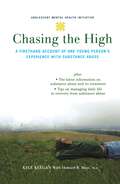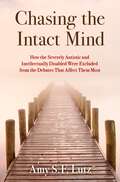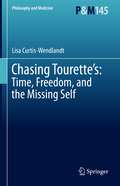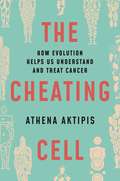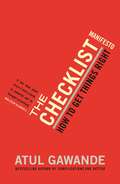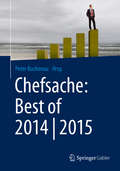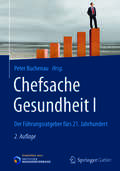- Table View
- List View
Chasing Life
by Dr Sanjay GuptaPractical immortality may be within our grasp, due to cutting-edge scientific research and amazing medical breakthroughs that are coming at an astonishing speed. In Chasing Life, prominent neurosurgeon and CNN Chief Medical Correspondent Dr Sanjay Gupta blends accounts of discoveries from around the world with advice for optimal health and longevity.For centuries, adventurers and scientists have believed that not only could we delay death but that 'practical immortality' was within our reach. Today, many well-respected researchers would be inclined to agree. In a book that is not about anti-aging, but about functional aging - extending your healthy, active life - Dr. Sanjay Gupta brings together compelling stories of the most up-to-date scientific breakthroughs from around the world, with cutting-edge research and advice on achieving practical immortality in this lifetime.Gupta's advice is often counterintuitive: longevity is not about eating well, but about eating less; nutritional supplements are a waste of your money; eating chocolate and drinking coffee can make you healthier. Chasing Life tells the stories behind the breakthroughs while also revealing the practical steps readers can take to help extend youth and life far longer than ever thought possible.
Chasing Molecules: Poisonous Products, Human Health, and the Promise of Green Chemistry
by Elizabeth GrossmanElizabeth Grossman, an acclaimed journalist who brought national attention to the contaminants hidden in computers and other high tech electronics, now tackles the hazards of ordinary consumer products. She shows that for the sake of convenience, efficiency, and short-term safety, we have created synthetic chemicals that fundamentally change, at a molecular level, the way our bodies work. The consequences range from diabetes to cancer, reproductive and neurological disorders.Yet it’s hard to imagine life without the creature comforts current materials provide—and Grossman argues we do not have to. A scientific revolution is introducing products that are “benign by design,” developing manufacturing processes that consider health impacts at every stage, and is creating new compounds that mimic rather than disrupt natural systems. Through interviews with leading researchers, Grossman gives us a first look at this radical transformation.
Chasing Pain: The Search for a Neurobiological Mechanism
by Kenneth L. CaseyConceptual models of how pain is created influence medical practice, neuroscientific research, and philosophical ideas about pain and other neurological functions. Given the broad scope of pain experiences, realistic models of pain neurobiology must consider the correlation between pain and tissue damage and how it is strongly affected by neurological disease, emotionally compelling circumstances, and by complex cognitive processes. Recent discoveries have made it clear that both sensory and affective systems are strongly modulated by activity in other sensory pathways and by affective and cognitive processes originating in the brain. As a result, pain should then be conceived as emerging from the conjoint activity of both sensory and affective neural systems, each becoming a target for pain treatment. Historically, pain has been conceived as emerging either from an undefined pattern of neural activity or from anatomically and physiologically unique structures in the nervous system. Observations made during the early and mid- 20th century showed that pain and pain-like behaviors normally require not only sensory detectors of noxious events (called nociceptors) but also brain affective (hedonic) mechanisms that generate emotional experience and expression. In Chasing Pain, pain specialists and neuroscientists will find a thoughtful discussion of the neuroscientific and clinical evidence that has led to contemporary concepts of pain neurobiology and how pain might emerge from neuronal activity. Written in a concise and annotated format, Doctor Kenneth Casey reveals that while contemporary research has greatly enriched our model of pain neurobiology, several important and therapeutically challenging clinical conditions remain poorly understood.
Chasing Pain: The Search for a Neurobiological Mechanism
by Kenneth L. CaseyConceptual models of how pain is created influence medical practice, neuroscientific research, and philosophical ideas about pain and other neurological functions. Given the broad scope of pain experiences, realistic models of pain neurobiology must consider the correlation between pain and tissue damage and how it is strongly affected by neurological disease, emotionally compelling circumstances, and by complex cognitive processes. Recent discoveries have made it clear that both sensory and affective systems are strongly modulated by activity in other sensory pathways and by affective and cognitive processes originating in the brain. As a result, pain should then be conceived as emerging from the conjoint activity of both sensory and affective neural systems, each becoming a target for pain treatment. Historically, pain has been conceived as emerging either from an undefined pattern of neural activity or from anatomically and physiologically unique structures in the nervous system. Observations made during the early and mid- 20th century showed that pain and pain-like behaviors normally require not only sensory detectors of noxious events (called nociceptors) but also brain affective (hedonic) mechanisms that generate emotional experience and expression. In Chasing Pain, pain specialists and neuroscientists will find a thoughtful discussion of the neuroscientific and clinical evidence that has led to contemporary concepts of pain neurobiology and how pain might emerge from neuronal activity. Written in a concise and annotated format, Doctor Kenneth Casey reveals that while contemporary research has greatly enriched our model of pain neurobiology, several important and therapeutically challenging clinical conditions remain poorly understood.
Chasing the High: A Firsthand Account of One Young Person's Experience with Substance Abuse (Adolescent Mental Health Initiative)
by Kyle Keegan Howard MossKyle Keegan was like many teenagers: eager to fit in at school, he experimented with alcohol and drugs. Soon, his abuse of these substances surpassed experimentation and became a ruthless addiction to heroin that nearly destroyed his life. Now in recovery, Keegan tells his remarkable story in Chasing the High. Starting with the early days of alcohol and drug use, Keegan charts his decline into crime and homelessness as his need for heroin surpassed all thoughts of family and friends, of right and wrong. He then goes on to use these experiences to offer guidance and practical advice to other young people who may be struggling with substance abuse. In straightforward, easy-to-understand language and along with the psychiatric expertise of Howard Moss, MD, Keegan discusses what is known about the neurobiology of addiction in young people, how to seek treatment, and how to get the most out of professional help. He also covers such topics as which therapies are used to combat addiction, how to talk to family and friends about substance abuse, and how to navigate risky situations. Both an absorbing memoir and a useful resource for young people. Part of the Adolescent Mental Health Initiative series of books written specifically for teens and young adults, Chasing the High is at once both an absorbing memoir and a useful resource. It offers hope to those who are struggling with substance abuse and will help them to overcome its challenges and to go on to lead healthy, productive lives.
Chasing the Intact Mind: How the Severely Autistic and Intellectually Disabled Were Excluded from the Debates That Affect Them Most
by Amy S. LutzA comprehensive introduction to the concept of the "intact mind" and how it affects disability policy and practice. The concept of the intact mind, first described in a 2006 memoir, refers to the idea that inside every autistic child is an intelligent, typical child waiting to be liberated by the right diet, the right treatment intervention, the right combination of supports and accommodations. The sentiment itself is not new. Emerging largely out of psychoanalytic theory dating back to the end of the 19th century, the intact mind was later amplified in memoirs, where parents wrote of their tireless efforts to free their children from the grip of autism. Though the idea gives hope to parents devastated by a child's diagnosis, Amy Lutz argues that it has also contributed to widespread dismantling of services badly needed by severely disabled children and their families. In Chasing the Intact Mind, Lutz traces the history of the intact mind concept, explaining how it influences current policy and practice affecting those with autism. Lutz provides a historical analysis of the intact mind narrative and describes how the concept--originally unique to autism--has come to inform current debates at the heart of intellectual and developmental disability practice and policy in the United States, including battles over sheltered workshops, legal guardianship, and facilitated communication. Lutz argues that focusing on the intact mind and marginalizing those with severe disability reproduces historic patterns of discrimination that yoked human worth to intelligence, and that it is only by making space for the impaired mind that we will be able to resolve these ongoing clashes--as well as even larger questions of personhood, dependency, and care.
Chasing the Intact Mind: How the Severely Autistic and Intellectually Disabled Were Excluded from the Debates That Affect Them Most
by Amy S. LutzA comprehensive introduction to the concept of the "intact mind" and how it affects disability policy and practice. The concept of the intact mind, first described in a 2006 memoir, refers to the idea that inside every autistic child is an intelligent, typical child waiting to be liberated by the right diet, the right treatment intervention, the right combination of supports and accommodations. The sentiment itself is not new. Emerging largely out of psychoanalytic theory dating back to the end of the 19th century, the intact mind was later amplified in memoirs, where parents wrote of their tireless efforts to free their children from the grip of autism. Though the idea gives hope to parents devastated by a child's diagnosis, Amy Lutz argues that it has also contributed to widespread dismantling of services badly needed by severely disabled children and their families. In Chasing the Intact Mind, Lutz traces the history of the intact mind concept, explaining how it influences current policy and practice affecting those with autism. Lutz provides a historical analysis of the intact mind narrative and describes how the concept--originally unique to autism--has come to inform current debates at the heart of intellectual and developmental disability practice and policy in the United States, including battles over sheltered workshops, legal guardianship, and facilitated communication. Lutz argues that focusing on the intact mind and marginalizing those with severe disability reproduces historic patterns of discrimination that yoked human worth to intelligence, and that it is only by making space for the impaired mind that we will be able to resolve these ongoing clashes--as well as even larger questions of personhood, dependency, and care.
Chasing Tourette’s: Time, Freedom, and the Missing Self (Philosophy and Medicine #145)
by Lisa Curtis-WendlandtThis book offers a philosophical perspective on contemporary Tourette Syndrome scholarship, a field which has exploded over the last thirty years. Despite intense research efforts on this common neurodevelopmental condition in the age of the brain sciences, the syndrome’s causes and potential cures remain intriguingly elusive. How does this lack of progress relate to the tacitly operating philosophical concepts that shape our current thinking about Tourette Syndrome? This book foregrounds these tacit concepts and shows how they relate to “big topics” in philosophy such as time, volition, and the self. By tracing how these topics relate to current research on Tourette’s, it invites us to re-think our approach to research and care. Such re-thinking is urgently needed: individuals and families living with Tourette Syndrome remain under-serviced as pharmacological and behavioural therapies provide relief for some but not all who need support. This book highlights what questions we ask and do not ask in contemporary scholarship, thereby surfacing invisible constraints and opportunities in the field. It is of interest to scholars, health professionals, students, and affected families who want to better understand this burgeoning field of research with its conceptual controversies, approaches to aetiology, and directions for new research and improved clinical care.
Chassin's Operative Strategy in Colon and Rectal Surgery
by C. HenselmannThis book includes step-by-step depictions of twenty-eight operative procedures in colorectal surgery. Chassin’s Operative Strategy in Colon and Rectal Surgery is a succinct analysis of surgical procedures for colorectal disorders. Spanning from well-established legacy procedures to the most up-to-date minimally invasive approach, this brilliantly illustrated atlas particularly discusses the theoretical basis of the operations as well as the strategies crucial to evading common pitfalls.
Chassin's Operative Strategy in Esophageal Surgery
by C. HenselmannTrue Atlas, brilliantly illustrated. Succint review of surgical techniques, including minimally invasive approaches for GERD. Step by Step descriptions of 13 operative procedures in esophageal surgery. Significantly lower priced than it's competitors. Educed from Chassin's Operative Strategies in General Surgery, bound to be a classic.
Chassin's Operative Strategy in General Surgery: An Expositive Atlas
by Carol E.H. Scott-ConnerThe Fourth Edition of Chassin’s Operative Strategy in General Surgery: An Expositive Atlas is designed to expand this comprehensive and unique general surgery reference while remaining true to the special character of the work. This unique text continues to provide an emphasis on surgical strategy that is unmatched by other textbooks of surgical technique. It continues to comprehensively cover all non-vascular operations commonly performed by general surgeons. As always, Chassin’s explains the conceptual basis of each operation, outlines strategies to avoid common pitfalls, and carefully describes and beautifully illustrates the technical steps of each operation. The Fourth Edition has been expanded and updated by adding both new procedures and new features. A significant new feature, “Documentation Basics” has been added to each chapter, providing a bulleted list of key features that need to be listed in the operative note to accurately describe extent of procedure and enhance accuracy of coding.General surgery continues to evolve. Procedures are added and many operations are done through new minimal access approaches. However, as a surgeon may be called upon to perform an operation that has become rare, Chassin’s unique “legacy” material has been retained for reference. In addition, 17 new chapters have been added, including 4 new chapters on colorectal surgery. Over 1100 elegant illustrations and new radiographs accompany detailed textual explanations. More than ever, Chassin’s Operative Strategy in General Surgery: An Expositive Atlas, Fourth Edition is an indispensable reference for all surgical residents and practicing surgeons.
Chassin's Operative Strategy in General Surgery: An Expositive Atlas
by C. HenselmannThis up-to-date third edition of the classic provides a clear exposition of all basic surgical procedures. This is includes: surgery of the digestive tract, breast, abdominal wall, selected head and neck, and endocrine system. It also features numerous detailed illustrations by Caspar Henselmann. It is essential reading for residents and practising surgeons.
Chassin's Operative Strategy in General Surgery: An Expositive Atlas
by Ninh T. Nguyen Carol E. H. Scott-Conner Umut Sarpel Andreas M. Kaiser Sonia L. SuggThis fifth edition of Chassin's Operative Strategy in General Surgery is a major revision that strives to remain faithful to the purpose and tone of Dr. Chassin’s original text. This unique textbook provides an emphasis on surgical strategy that is unmatched by other textbooks of surgical technique. The text explains the conceptual basis of each operation, outlines strategies to avoid common pitfalls, and carefully describes and beautifully illustrates the technical steps of each operation. The fifth edition preserves the unique qualities of its previous edition while providing a comprehensive update. This updated volume also features a vast amount of richly detailed artwork and operative photographs, which help depict operative techniques step-by-step. No other text so successfully combines operative technique with the concept of strategy – that is, key governing principles that dictate safe surgery and avoidance of complications. There are books of technique, there are books about complications, and there are books about the rationale involved in the treatment of various kinds of surgical pathology. Chassin’s combines all three.Chassin’s Operative Strategy in General Surgery: An Expositive Atlas Fifth Edition comprehensively covers all non-vascular operations commonly performed by general surgeons. This edition expands this comprehensive general surgery reference while remaining true to the special character of the work. The revision expands upon procedures not covered in the previous edition and incorporates new techniques into many other chapters.
The Cheating Cell: How Evolution Helps Us Understand and Treat Cancer
by Athena AktipisA fundamental and groundbreaking reassessment of how we view and manage cancer When we think of the forces driving cancer, we don’t necessarily think of evolution. But evolution and cancer are closely linked, for the historical processes that created life also created cancer. The Cheating Cell delves into this extraordinary relationship, and shows that by understanding cancer’s evolutionary origins, researchers can come up with more effective, revolutionary treatments.Athena Aktipis goes back billions of years to explore when unicellular forms became multicellular organisms. Within these bodies of cooperating cells, cheating ones arose, overusing resources and replicating out of control, giving rise to cancer. Aktipis illustrates how evolution has paved the way for cancer’s ubiquity, and why it will exist as long as multicellular life does. Even so, she argues, this doesn’t mean we should give up on treating cancer—in fact, evolutionary approaches offer new and promising options for the disease’s prevention and treatments that aim at long-term management rather than simple eradication. Looking across species—from sponges and cacti to dogs and elephants—we are discovering new mechanisms of tumor suppression and the many ways that multicellular life-forms have evolved to keep cancer under control. By accepting that cancer is a part of our biological past, present, and future—and that we cannot win a war against evolution—treatments can become smarter, more strategic, and more humane.Unifying the latest research from biology, ecology, medicine, and social science, The Cheating Cell challenges us to rethink cancer’s fundamental nature and our relationship to it.
The Cheating Cell: How Evolution Helps Us Understand and Treat Cancer (PDF)
by Athena AktipisA fundamental and groundbreaking reassessment of how we view and manage cancer When we think of the forces driving cancer, we don’t necessarily think of evolution. But evolution and cancer are closely linked, for the historical processes that created life also created cancer. The Cheating Cell delves into this extraordinary relationship, and shows that by understanding cancer’s evolutionary origins, researchers can come up with more effective, revolutionary treatments.Athena Aktipis goes back billions of years to explore when unicellular forms became multicellular organisms. Within these bodies of cooperating cells, cheating ones arose, overusing resources and replicating out of control, giving rise to cancer. Aktipis illustrates how evolution has paved the way for cancer’s ubiquity, and why it will exist as long as multicellular life does. Even so, she argues, this doesn’t mean we should give up on treating cancer—in fact, evolutionary approaches offer new and promising options for the disease’s prevention and treatments that aim at long-term management rather than simple eradication. Looking across species—from sponges and cacti to dogs and elephants—we are discovering new mechanisms of tumor suppression and the many ways that multicellular life-forms have evolved to keep cancer under control. By accepting that cancer is a part of our biological past, present, and future—and that we cannot win a war against evolution—treatments can become smarter, more strategic, and more humane.Unifying the latest research from biology, ecology, medicine, and social science, The Cheating Cell challenges us to rethink cancer’s fundamental nature and our relationship to it.
Check-up Anästhesiologie: Standards Anästhesie - Intensivmedizin - Schmerztherapie - Notfallmedizin
by Wolfgang J. Kox Claudia D. SpiesIhr "Rezeptbuch" für die Qualitätssicherung und Vorbereitung auf die DRGs. Die Charité veröffentlicht als erste Klinik ihre seit über 2 Jahren bewährten Standards in der Anästhesie, Schmerztherapie, Intensiv- und Notfallmedizin. Beispielhaft dargestellt zum schnellen Nachschlagen und zum praktischen Handeln. Ihr Plus: - Hinweise auf kritische Situationen - Raum für kleine Notizen
Check-up Anästhesiologie: Standards Anästhesie - Intensivmedizin - Schmerztherapie - Notfallmedizin
by Wolfgang J. Kox Claudia D. SpiesPatientenversorgung auf hohem Niveau! Qualitätssicherung wird zunehmend gefordert – dies kann nur anhand von bewährten und abgesicherten Standards erfolgen. Beispielhaft hat die Charité alle anästhesierelevanten Verfahren und Vorgehen zum schnellen Nachschlagen standardisiert aufbereitet: Anästhesiologisches Vorgehen in allen operativen Fachgebieten - Intensivmedizin - Notfallmedizin - Schmerztherapie Neu in der 2. Auflage: Alle SOPs aktualisiert und überarbeitet! Perioperative Betablockade, Nierentransplantation, Kardiotechnik, Schmerztherapie in der Schwangerschaft, Antimikrobielle Therapie auf der Intensivstation, Anästhesieleistungen bei diagnostischen und therapeutischen Maßnahmen in Sonderbereichen. Konsequent in der Darstellung – aktuell an Inhalten – unverzichtbar in der Praxis: Für jeden in der Anästhesie Tätigen, Verantwortlichen sowie Klinik- und Verwaltungsdirektoren.
Check Up: Our NHS @70 (Oberon Modern Plays)
by Mark ThomasCelebrating the 70th anniversary of the founding of the NHS, award-winning comedian and activist Mark Thomas takes a look at our NHS, what state it’s in, where it’s going, and what we need to do to keep it.
The Checklist Manifesto: How To Get Things Right
by Atul GawandeTHE GAME-CHANGING BOOK FROM THE BESTSELLING AUTHOR OF BEING MORTAL Today we find ourselves in possession of stupendous know-how, which we willingly place in the hands of the most highly skilled people. But avoidable failures are common, and the reason is simple: the volume and complexity of our knowledge has exceeded our ability to consistently deliver it - correctly, safely or efficiently. In this groundbreaking book, Atul Gawande makes a compelling argument for the checklist, which he believes to be the most promising method available in surmounting failure. Whether you're following a recipe, investing millions of dollars in a company or building a skyscraper, the checklist is an essential tool in virtually every area of our lives, and Gawande explains how breaking down complex, high pressure tasks into small steps can radically improve everything from airline safety to heart surgery survival rates. Fascinating and enlightening, The Checklist Manifesto shows how the simplest of ideas could transform how we operate in almost any field.
Checkpoint Controls and Cancer: Volume 1: Reviews and Model Systems (Methods in Molecular Biology #280)
by Axel H. SchönthalIntracellular checkpoint controls constitute a network of signal transd- tion pathways that protect cells from external stresses and internal errors. Ext- nal stresses can be generated by the continuous assault of DNA-damaging agents, such as environmental mutagens, ultraviolet (UV) light, ionizing radiation, or the reactive oxygen species that can arise during normal cellular metabolism. In response to any of these assaults on the integrity of the genome, the activation of the network of checkpoint control pathways can lead to diverse cellular responses, such as cell cycle arrest, DNA repair, or elimination of the cell by cell death (apoptosis) if the damage cannot be repaired. Moreover, internal errors can occur during the highly orchestrated replication of the cellular genome and its distribution into daughter cells. Here, the temporal order of these cell cycle events must be strictly enforced—for example, to ensure that DNA replication is c- plete and occurs only once before cell division, or to monitor mitotic spindle assembly, and to prevent exit from mitosis until chromosome segregation has been completed. Thus, well functioning checkpoint mechanisms are central to the maintenance of genomic integrity and the basic viability of cells and, the- fore, are essential for proper development and survival. The importance of proper functioning of checkpoints becomes plainly obvious under conditions in which this control network malfunctions and fails. Depending on the severity and timing, failure of this machinery can lead to embryonic lethality, genetic diseases, and cancer.
Checkpoint Controls and Cancer: Volume 2: Activation and Regulation Protocols (Methods in Molecular Biology #281)
by Axel H. SchönthalIntracellular checkpoint controls constitute a network of signal transd- tion pathways that protect cells from external stresses and internal errors. Ext- nal stresses can be generated by the continuous assault of DNA-damaging agents, such as environmental mutagens, ultraviolet (UV) light, ionizing radiation, or the reactive oxygen species that can arise during normal cellular metabolism. In response to any of these assaults on the integrity of the genome, the activation of the network of checkpoint control pathways can lead to diverse cellular responses, such as cell cycle arrest, DNA repair, or elimination of the cell by cell death (apoptosis) if the damage cannot be repaired. Moreover, internal errors can occur during the highly orchestrated replication of the cellular genome and its distribution into daughter cells. Here, the temporal order of these cell cycle events must be strictly enforced—for example, to ensure that DNA replication is c- plete and occurs only once before cell division, or to monitor mitotic spindle assembly, and to prevent exit from mitosis until chromosome segregation has been completed. Thus, well functioning checkpoint mechanisms are central to the maintenance of genomic integrity and the basic viability of cells and, the- fore, are essential for proper development and survival. The importance of proper functioning of checkpoints becomes plainly obvious under conditions in which this control network malfunctions and fails. Depending on the severity and timing, failure of this machinery can lead to embryonic lethality, genetic diseases, and cancer.
Checkpoint Controls and Targets in Cancer Therapy (Cancer Drug Discovery and Development)
by Zahid H. SiddikMuch work over the last two decades has firmly established that loss of cell cycle checkpoint regulation, and resultant unabated cellular proliferation, is an inherent characteristic of cancer. This loss may occur through aberration in any single component involved in signal transduction pathways that orchestrate checkpoint regulation, which may manifest through either a failure to activate the checkpoint or a failure to respond to the activated checkpoint. In normal cells, checkpoint pathways are activated when genetic or cellular homeostasis is compromised, and signals are then transduced to re-stabilize homeostasis, and, failing this, to activate the apoptotic machinery to induce a cellular suicidal response. This implies that both survival and cell death pathways are induced following checkpoint activation, and that the final decision is dependant on the net result of integrating the two sets of signals. It is intriguing that checkpoint pathways are also critical in cancer therapy to provide an apoptotic stimulus when cellular damage induced by the therapeutic agent is detected by the sensor system. Therefore, it is not surprising that failure in pro-survival checkpoint response will render tumor cells hypersensitive to cytotoxics and, conversely, failure in pro-apoptotic checkpoint response will induce genetic instability and/or therapeutic resistance. Understanding the intricacies of checkpoint response is, therefore, central to the design of therapeutic regimen that will enhance antitumor effects. Although early versions of this design entail combination of cytotoxic agents with cell cycle or checkpoint inhibitors, a greater understanding of the concepts could make such combinations clinically more effective. The contributions in this book will consolidate the current state of knowledge on checkpoint responses that may lay the foundation for hypothesis-driven rational approaches in advancing the management of cancer. The immediate attraction of the book to the scientific community is that it represents a timely opportunity to build upon existing concepts of checkpoints to expand our understanding of the inner workings of the critical checkpoint machinery. The present understanding has provided ample appreciation that response to checkpoint activation is manifested through coordinated inhibition of cyclin-dependent kinase (CDK) complexes in G1, S and/or the G2 phase in order to arrest the cell cycle. Kinase inhibition can occur through several mechanisms, including inhibitory phosphorylation of CDK, destruction of the cognate cyclins, and recruitment of CDK inhibitors from the INK and WAF1/CIP1 families. However, the wealth of information from recent discoveries needs to be examined critically to consolidate our conceptual knowledge of checkpoints. At the same time, there is acute awareness in the diversity of checkpoint response between cytotoxic agents, and this serves as a reminder of the magnitude of complexity that is inherent in checkpoint regulation. This volume is intended to bring the cancer research community closer toward an improved understanding of this regulation, how checkpoint abnormalities can impact negatively on cancer therapy, and emerging strategies to target checkpoint response as a therapeutic end-point.
Checkpoint Responses in Cancer Therapy (Cancer Drug Discovery and Development)
by Wei DaiExtensive research has uncovered a set of molecular surveillance mechanisms – commonly called “checkpoints” – which tightly monitor cell-cycle processes. Today’s anticancer drug development has identified many of these cell-cycle checkpoint molecules as effective targets. Research now promises to uncover a new generation of anticancer drugs with improved therapeutic indices based on their ability to target emerging checkpoint components. Checkpoint Responses in Cancer Therapy summarizes the advances made over the past 20 years, identifying components of cell-cycle checkpoints and their molecular regulation during checkpoint activation and validating the use of checkpoint proteins as targets for the development of anticancer drugs. This book’s distinguished panel of authors takes a close look at topics ranging from the major molecular players affecting DNA synthesis and the response to DNA damage to advances made in the identification of chemical compounds capable of inhibiting individual mitotic kinases. Illuminating and authoritative, Checkpoint Responses in Cancer Therapy offers a critical summary of findings for researchers in the pharmaceutical and biotechnology industries and a valuable resource for academic scientists in cancer research and the study of cell-cycle regulation, signal transduction and apoptosis.
Chefsache: Best Of 2014-2015
by Peter BuchenauDie Chefsache-Reihe von Peter Buchenau führt innovative Autoren verschiedenster Branchen und Denkansätze zusammen und beschäftigt sich mit Themen rund um Gesundheit, Prävention, Betriebskita, Kopf, Social Media Marketing, Leisure Sickness, Männer oder Frauen. Die 34 erfolgreichsten Beiträge aus 2014/2015 werden hier in Kurzform noch einmal dargestellt. Alle Autoren sind in ihrem jeweiligen Fachgebiet anerkannte Experten. Mit ihren Texten tragen sie dazu bei, Ihren unternehmerischen und auch persönlichen Erfolg nachhaltig zu sichern. Durch die komprimierte Form der dargestellten Expertentipps eignet sich dieser Chefsache-Band besonders für den schnellen Leser, der wenig Zeit hat.
Chefsache Gesundheit I: Der Führungsratgeber fürs 21. Jahrhundert
by Peter BuchenauDas Fachbuch beschäftigt sich mit der Gesundheit von Mitarbeitern in Unternehmen. Gesundheit wird zur Chefsache und zum Wirtschaftsfaktor in Unternehmen. Der demografische Wandel und ein damit verbundener Mangel an leistungsfähigen Führungs- und Fachkräften, der stete Druck, sich an einem globalisierten Markt zu beweisen, die immer komplexer werdenden Prozesse der internen Administration – all dies stellt Unternehmen und Mitarbeiter vor enorme Herausforderungen. Umso wichtiger wird es in diesem Zusammenhang, die wertvolle Ressource Mensch zu schützen und dessen Arbeitskraft zu erhalten. 15 Coaches, Berater und Trainer beschreiben bezogen auf ihr jeweiliges Fachgebiet, welchen Einfluss der Faktor Gesundheit künftig auf Unternehmen haben wird, und geben praktische Hinweise für einen zeitgemäßen Umgang mit diesem wichtigen Thema. Für die 2. Auflage wurden drei neue Beiträge ergänzt.



